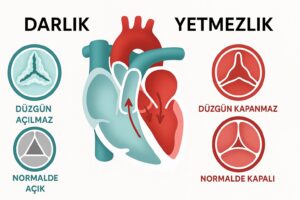Aort kapak hastalıkları, kalp kapak hastalıkları arasında en sık görülen rahatsızlıklardan biridir. Bu hastalıklar, aort kapağının yapısal bozukluklarına bağlı olarak ortaya çıkar ve genellikle iki temel başlık altında incelenir: Aort Kapak Darlığı ve Aort Kapak Yetmezliği.
Bu yazıda, aort kapak hastalıklarının nedenlerini, belirtilerini, tanı yöntemlerini ve tedavi seçeneklerini özetleyerek, darlık ile yetmezlik arasındaki temel farkları net bir şekilde açıklıyoruz.
Aort Kapak Hastalıkları Nedir?
Kalbimizde dört kapak bulunur ve bu kapaklar kanın kalp içinde ve tüm vücutta doğru yönde akmasını sağlar. Bu kapaklardan biri olan aort kapağı, kalbin sol karıncığı ile aort damarı arasında yer alır. Aort kapak hastalıkları, bu kapağın yapısal bozulmasına bağlı olarak iki şekilde karşımıza çıkar:
- Aort Kapak Darlığı: Aort kapağının daralması sonucu kalbin kan pompalaması zorlaşır.
- Aort Kapak Yetmezliği: Aort kapağının tam kapanmaması nedeniyle pompalanan kanın bir kısmı kalbe geri kaçar.
Her iki durum da kalp fonksiyonlarını olumsuz etkiler ve zamanla kalp yetmezliğine neden olabilir.
Aort Kapak Darlığı ve Yetmezliği Arasındaki Farklar
| Özellik | Aort Kapak Darlığı | Aort Kapak Yetmezliği |
|---|---|---|
| Tanım | Aort kapağının daralması | Aort kapağının tam kapanmaması |
| Temel Sebep | Kireçlenme, romatizmal ateş, doğumsal anomaliler | Aort kökü genişlemesi, romatizmal ateş, doğumsal nedenler |
| Klinik Belirtiler | Nefes darlığı, göğüs ağrısı, baş dönmesi, bayılma | Nefes darlığı, yorgunluk, çarpıntı, düzensiz kalp atışı |
| Tanı Yöntemi | Ekokardiyografi | Ekokardiyografi |
| Tedavi | İlaç, cerrahi kapak değişimi, TAVİ yöntemi | İlaç, kapak tamiri veya değişimi |
| Ameliyat Gerekliliği | Şiddetli vakalarda | Şiddetli vakalarda |

Aort Kapak Hastalıklarının Nedenleri
Aort kapak hastalıklarının başlıca nedenleri şunlardır:
- Yaşlanmaya bağlı dejeneratif değişiklikler
- Romatizmal ateş
- Doğumsal kapak anomalileri (Biküspid Aort Kapağı)
- Aort anevrizması
- Bağ dokusu hastalıkları (Marfan sendromu, Ehlers-Danlos sendromu)
- Göğüs travmaları
Aort Kapak Hastalıklarının Belirtileri
Aort kapak hastalıklarının belirtileri hastalığın türüne ve şiddetine göre değişir. En sık görülen belirtiler şunlardır:
- Nefes darlığı
- Göğüs ağrısı
- Çarpıntı
- Yorgunluk
- Baş dönmesi
- Bayılma
- Kalpte üfürüm
Aort Kapak Hastalıklarının Tanısı Nasıl Konur?
Tanı için en sık kullanılan yöntem ekokardiyografidir. Ayrıca şu testler de yardımcıdır:
- EKG
- Göğüs röntgeni
- Kardiyak MR
- Kalp kateterizasyonu
Aort Kapak Hastalıklarının Tedavi Yöntemleri
Tedavi, hastalığın türüne, şiddetine ve hastanın genel sağlık durumuna göre planlanır:
İlaç Tedavisi
Hafif vakalarda semptomları kontrol altına almak için ilaç tedavisi uygulanır.
Cerrahi Müdahale
Kalp fonksiyonlarının bozulduğu veya şikayetlerin arttığı durumlarda cerrahi yöntemler tercih edilir:
- Aort Kapak Değişimi (AVR)
- Kapak Tamiri
- TAVİ (Transkateter Aort Kapak İmplantasyonu)
- Mini Kapak Değişimi
- Dikişsiz Kapak Değişimi
Cerrahi kararı, hastanın yaşı, genel sağlık durumu ve kapak hastalığının derecesi dikkate alınarak verilir.
Aort Kapak Hastalıklarında Erken Tanının Önemi
Aort kapak hastalıkları ilerleyici seyir gösterir. Bu nedenle erken tanı, yaşam kalitesinin korunması ve kalp fonksiyonlarının bozulmadan müdahale edilmesi açısından son derece önemlidir. Özellikle nefes darlığı, göğüs ağrısı veya bayılma gibi belirtileriniz varsa vakit kaybetmeden bir kardiyoloji uzmanına başvurmalısınız.
